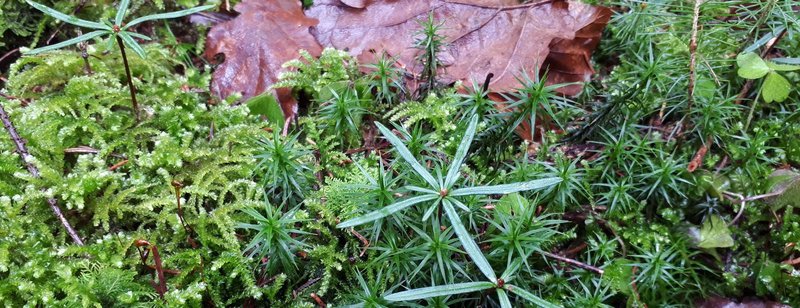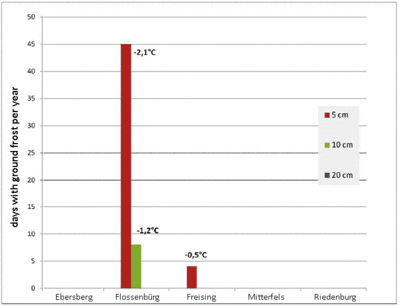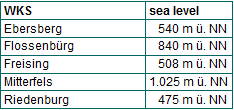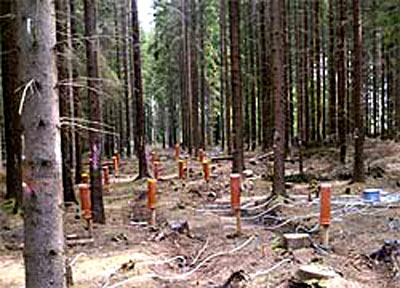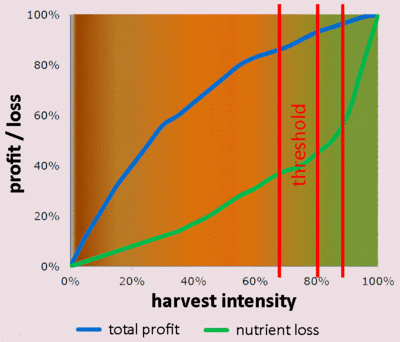Forest soil as a water storage facilitator
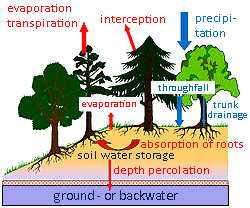
Fig. 2: The hydrological balance of a site is driven by precipitation, soil and evapotranspiration.
The hydrologic balance of a site is of considerable value for the growth of trees. This balance is driven by precipitation (input variable), the soil (storage variable) and evapotranspiration (output variable). Water, which either is not utilized for transpiration or lost through soil water evaporation, percolates into the groundwater (Fig. 2). The soil can only take up water that comes in through precipitation in the forest stand. With regard to climate change, precipitation and evapotranspiration will vary and the site factors cannot be assumed as a constant. The question arises: Is there going to be enough water?
There are two aspects which remain common despite the various predictions for climate change: The temperatures will rise due to the increase in greenhouse gases in the atmosphere and a shift in precipitation will take place from the summer months to the winter.
The higher temperatures will lead to a higher demand for water from the vegetation that will not be met from the amount of precipitation. The water storage of the soil will be depleted sooner and will probably not be sufficient for the trees until the time of the next rainfall event. In times of water shortages, the stoma of the trees close (Box 1) and reduce the CO2 uptake. This can lead to a decrease in growth and weaken the tree. In extreme situations the tree can suffer irreparable damage when air finds its way into the plant tissue.
Measurements at the forest climate stations (WKS) allow for a prognosis of the future climate. It can be inferred that water deficiencies will occur earlier in the year. In about sixty to ninety years, the one hundred year drought in 2003 will become the norm. As a result, years with a good hydrological balance will cease to exist and the chance for recovery will therefore be reduced.
The hydrological balance is primarily determined from the Bavarian climate and small-scale variations are due to the soils. Results of the second national soil inventory (BZE II) reveal that three quarters of the plots in Bavaria have the hydrological balance classification of moderately moist to moist, only four percent were classified as dry. With the climate change scenario B1 the classification will drastically change: almost two thirds of the sites will be classified as dry or moderately dry, alone twenty eight percent are classified as dry (Fig. 3). This rough estimate gives an insight as to how the hydrological balance will develop in Bavaria during climate change.
The soil is also directly affected by climate change:
- The soil profile will dry out faster and more intensely.
- The change from dry to moist will increase so that soil flora and fauna will have to deal with more extremities.
- The decomposition of the humus layer could become stronger with an increase in temperature.
- The wetting resistance of the humus layer is higher when it’s dried out. Precipitation therefore will flow more often on the surface (like Hortonian flow) or it will percolate faster. Lastly, the production of cracks in clayey substrates can become more prevalent.
- All together, the buffer capacity of the soils will generally decrease and exacerbate problems with the hydrological balance.
It is difficult to positively influence the ability for soil to store water. Thus, it is necessary to maintain high humus content and a loose stratification in order to compensate for droughts and support this important function. Recommendations for mitigation target silvicultural activities and the choice of tree species. When converting the species composition in forest stands tree species with drought tolerance should utilized. Additionally, mixed stands also reduce risk. The usage of artificial regeneration in combination with shelterwood type harvests preserves the present soil condition. It is yet to be determined if thinning operations can reduce the water consumption of the stand.
In conclusion, the question "is there enough water?" can be answered with "yes", but not necessarily for the tree species that currently stock the respective sites in Bavaria.
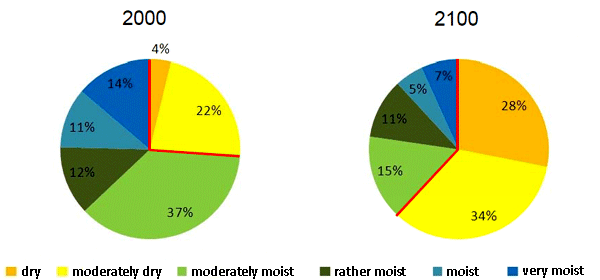
Fig. 3: In Bavaria, approximately a quarter of all sites lie within a dry to moderately dry hydrological balance classification. This will change by 2100 when almost two thirds of the sites will be found in this classification.
Ground frost – or: the right time to traverse the soil with machines
The weight of modern harvesters and forwarders are distributed over a larger area when the soils are frozen. But how often does the ground freeze?
The soil temperature in the forest is buffered against large fluctuations through the canopy and other stand characteristics (e.g. soil vegetation, humus etc.). Whereas areas free of vegetation (average elevation 480 m above sea level) reach 0 °C or lower at a soil depth from five centimeters on twenty-five days in the year, grassy areas at a higher elevation (655 m above sea level) only reach such temperatures in the soil on only 14 days of the year. With an increase in soil depth there is a decrease in the number days on which the soil will be frozen. How does it look in the stands?
In the stands on which five focal forest climate stations are operated (Tab. 1) it was extremely rare to record temperatures below zero at a depth of five centimeters (ground frost). Only at the WKS Flossenbürg did the temperature fall below 0 °C at a depth of five centimeters for forty-five days in the year (Fig. 4). It was surprising that the WKS Mitterfels, which lies at a higher elevation, had absolutely no occurrences of ground frost. This is mainly attributable to snow depth and the constant snow cover on both sites. The WKS Mitterfels is characterized by plentiful amounts of snow and also sufficiently isolates the soil from frost at this elevation.
The analysis of the data revealed that in order to achieve ground frost in the topmost soil horizon, the air temperature has to sink below -13 °C on three consecutive days. The soil water content not only influences how fast warmth can be directed into the soil, but also how much warmth is necessary in order to increase the soil temperature. It is additionally used to determine how well the soil can be traversed with machines and how much soil damage can occur from an inappropriate utilization of machinery. The measurements from the WKS revealed that on average, the lowest amount of soil water is at the end of the vegetations period in September. It is therefore recommended to begin harvest operations directly after the end of the vegetation period.
It can be concluded that in the forest ground frost rarely comes to be. With the warming due to climate change, the occurrence of ground frost will even more seldom in the future. Decisive for the use of forest machinery during harvests is an appropriate level of soil moisture. On average, this level is reached in the middle or end of the vegetation period. With this in mind, the technical possibilities (bogie tracks, low tire pressure etc.) should definitely be utilized in order to avoid long-term soil damage.
Nutrient relocation
Soil damage should also be reduced through the use of branch mats. This can cause a significant relocation of nutrients with repeated thinning operations. The nutrients that were once stored in the canopy will then be concentrated on the logging trails. In contrast, the majority of the tree canopies are evenly distributed through out the stand with a conventional harvest. The other variant is fully mechanized harvesting where whole trees and canopies are removed and used for the production of energy.
On two sites (Pflugbühl and Höglwald) both the effects of the branch mats for the physical protection of the soil were studied as well as nutrient relocation. The goal of the study was to see if the relocated nutrients were reintegrated into the nutrient cycle and utilized by the adjacent trees or if the nutrients were leached into the groundwater.
At Pflugbühl there are predominately good site conditions and soil can be traversed well with forest machinery. Here the negative effects of the traversal on the soil physical characteristics can be significantly reduced by the use of branch mats. On the sensitive site of Höglwald there are unfavorable conditions for the use of forest machinery. Even with the use of branch mats there was still a considerable amount of root damage on this site. This was demonstrated by the poor water uptake from the trees on the logging trails. In contrast, the water uptake with branch mats was considerably higher than without branch mats. The logging trails are not just advantageous for mechanized forestry, but are also useful for nutrient and water uptake for trees adjacent to the trails. This area of the stand will not suffer losses in timber production. The trees next to the logging trails in Pflugbühl profit from the branch mats and show an increase in growth.
The majority of the displaced nutrients remained in the system for the length of the study. This extremely reduced the nutrient loss through harvesting. A significant increase in potassium and magnesium could be seen on the logging trails with branch mats. The displaced nutrients were hardly leached from the site. As a rule, on both locations there was not a decrease in the quality of the soil solution that entered the groundwater even though infrequently high nitrate concentration in Pflugbühl occurred.
Possibilities and limitation to biomass usage
Unmanaged forests are built upon cycles by their nature: Except for carbon, almost 100 % of the nutrients remain in the system and are reprocessed over long periods of time. These cycles change in response from one-way inputs from the atmosphere into nutrient flows. Forests loose nutrients through the harvest of stems and canopy material. The consequences of an overuse (e.g. the infamous practice of litter raking) are declines in timber production, which have been known about for quite some time.
There have been many promises made from the additional usage of biomass from tree crowns: an increase in financial yields, an answer to forest protection problems and ease the labor of planting and cultivating the successive stand. Furthermore, one can contribute to climate protection by substituting renewable resources for fossil fuels. It is imperative to find the correct middle ground. From our previously gained knowledge it can be concluded that this is highly dependent on site conditions and tree species.
The smaller part of the stems plus branches, twigs as well as needles and leaves are harvested with an increase in biomass harvest intensity. Since the largest monetary value resides in the stems, an increase in the harvest intensity brings a disproportionally small increase in yield. In comparison, whole tree harvesting removes a disproportionally high amount of nutrients. The harvest intensity is limited through thresholds that are established from both the nutrient balance and conservation of the nutrient capital.
There are four strategies for the usage of biomass:
- Abstention of crown harvests; the thresholds are not exceeded
- Crown harvest, only up to the threshold
- Crown harvest, with an exceedance of the threshold with compensation through fertilization
- Crown harvest, in exceedance of the threshold without a compensation through fertilization
Option 1: Only the stems are to be harvested. The abstention of a canopy harvest is to be seen as a "nutrient reserve" for the soil capital. As a result, the soil fertility will remain intact and further considerations for the nutrient budget are not necessary.
Option 2: By harvesting only a portion of the canopy, the site-specific threshold is approached but not surpassed. Information about the trend of the nutrient export curve and knowledge of the soil threshold is necessary. The usage of the crown material can only be deemed ecologically sound if verification through a bookkeeping system takes place.
Option 3: Fertilization does not generally fit the picture of near to nature forestry. It is questionable if mineral fertilizer can adequately replace the slow and steady release of nutrients through the decomposition of harvest residues. This variant is not recommended.
Option 4: This option forbids itself since it strongly taps to into the soil capital. However, this option can be chosen unintentionally if the level of the threshold is low and unknown plus the usage of biomass is high.
Limiting the usage of biomass from the crowns of trees is exclusively in the interest of the forest landowner. This helps to preserve the forest soil capital and, where possible, to enhance it in order to guarantee a constantly high amount of timber production.

